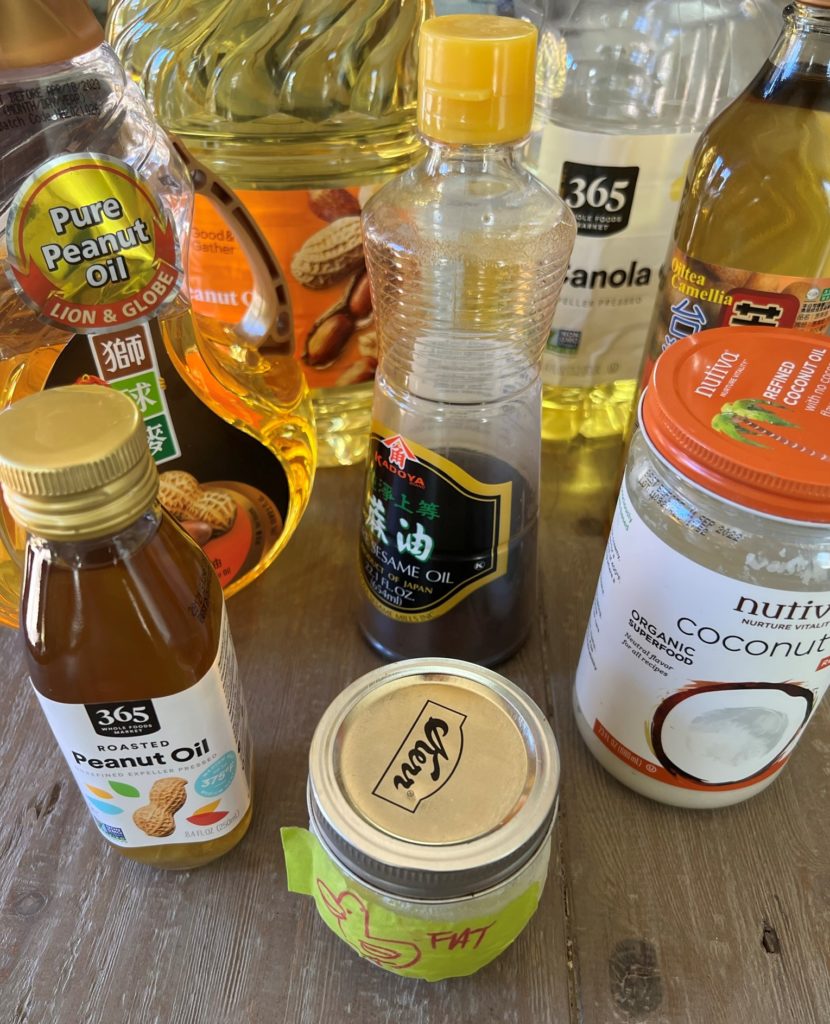
Perusing a supermarket Asian food section recently, I saw bottled cooking oil labeled as "Stir-Fry Oil" and thought it was something super fancy and special. It turned out to be cottonseed oil infused with garlic, onion and herbs. The oil by House of Tsang is suitable for high heat cooking, which I assume signals suitable for the wok. What if you don't want your food to be flavored by garlic, onion and unspecified herbs? I didn't purchase the product because I'd rather control my own flavors.
What is the best oil for stir-frying? There are many kinds of oils and fats that you may stir-fry with and I've tried several. The above photo captures most of what I'd use for stir-frying foods. They don't all work the same and when I write recipes for my cookbooks, I specify commonly found oils and then try to nudge people to experiment with the uncommon. People do have oil preferences that may be dictated by taste, diet, sustainability, and budget. I try to factor all that in but also include function: what is the oil's role in the dish? Here is a run-down of the oils I use in my kitchen for stir-frying. Feel free to add your experiences!
Neutral Flavor: Canola and Peanut Oil
Four out of five times when I stir-fry, I'm looking for a mostly neutral tasting fat to lubricate and enrich other ingredients. The oil is there to facilitate cooking more than to add flavor, and I'm likely to cook at high heat. For all those reasons, I reach for canola or refined peanut oil. They are both light oils, not as thick as say, corn oil. I prefer a non-GMO canola oil that's expeller pressed. I buy it in a large quantity and keep refill smaller bottles on my kitchen counter.
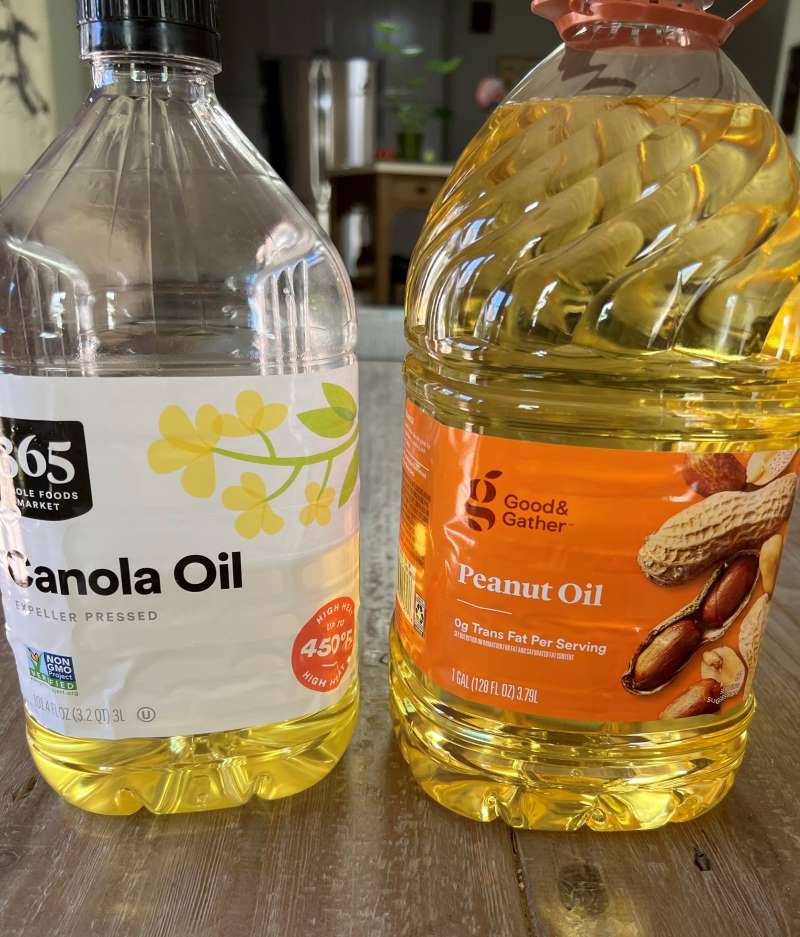
Ditto for the peanut oil, which I often purchase at Target because it's available in a money-saving large quantity. A blend of peanut oil from Argentina, India, Senegal, Nicaragua, and the USA, Target's peanut oil has a very faint peanut-flavor and aroma too. It is unavailable in smaller containers. Spectrum makes great refined peanut oil. Both the canola and peanut oils have smoking points of 450F, which is considered high.
In China, thick, yellow rapeseed oil is favored in many locations. The thickness is similar to corn oil. I noticed some Stateside Chinese markets selling Chinese rapeseed oil, which you'll notice is a richer color than Stateside canola. Check it out. Most canola oil is flavor neutral but I once had a non-GMO canola oil from the Midwest that was delicious tasting. Alas, the farmers said they only produced it for industrial use.
Not fond of canola or peanut oil? With a smoking point of 450F, refined sunflower oil is also good for stir-frying. It is light tasting as well. Grapeseed oil is also great, especially if its flavor is neutral; grapeseed oil's smoking point is roughly 420F. Rice bran oil is another wonderful oil to cook with but it is not well distributed. It's also a bit pricey. I've tried avocado oil, which has a smoking point of 500F, but the brand I used imparted a certain flavor to my food that I didn't like. Like rice bran, it can be expensive for folks.
Go Nuts for Refined, Semi-Refined, Unrefined Peanut Oil
Thank goodness I do not have a peanut allergy because I love the little legume. The cool thing about peanut oil is that you may purchase it as refined (for high heat cooking), semi-refined (moderately-hot heat cooking), and unrefined (moderate heat cooking). Moving from refined to unrefined, the flavor of the oil becomes nuttier. Unrefined peanut oil made from roasted peanuts smells and tastes like peanut butter! It's delicious.
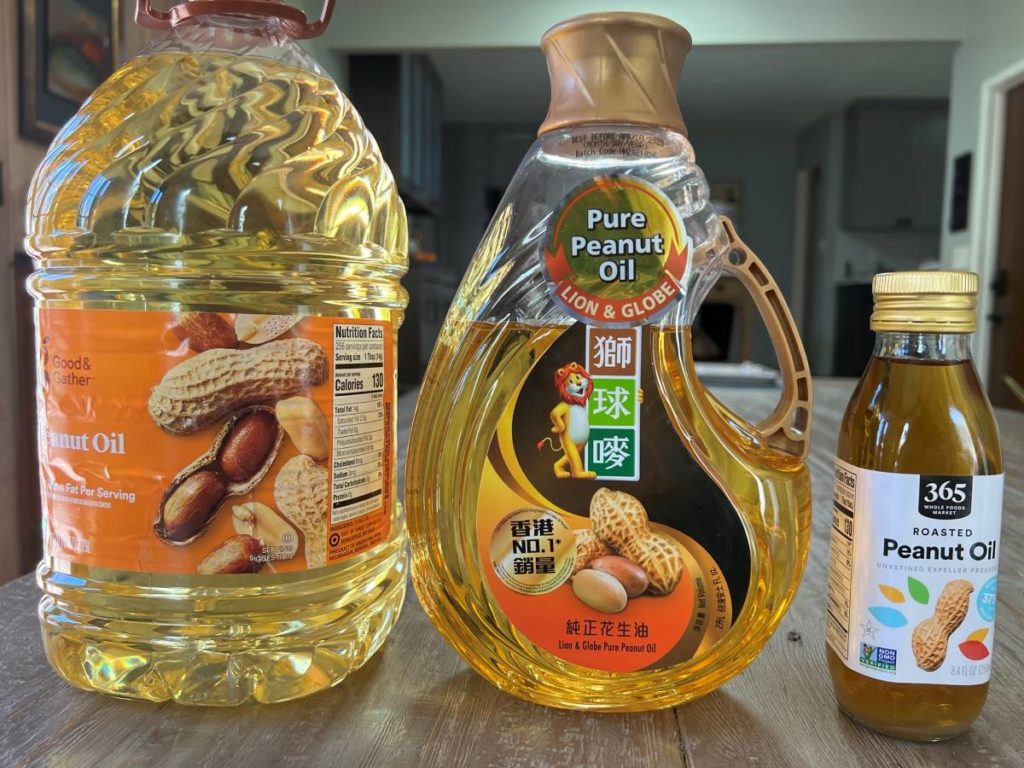
The one in the center is semi-refined peanut oil by Lion and Globe, a popular brand sold at Chinese markets. It is not labeled with a smoking point but I venture it's around 400F. When you shop for semi-refined peanut oil at an Asian market remember that it may be BLENDED with another oil, which makes it a lower price point. I favor the higher priced all-peanut version because I can always blend the semi-refined peanut oil, if I want to. The flavor is not big peanut but there is a pronounced fragrance.
Only have access to unrefined, roasted peanut oil and want to create a peanut-ty oil for stir-frying? Blend it! I use a 2-to-1 ratio of unrefined to refined peanut oil or canola oil. So, if you need 2 tablespoons, combine 4 teaspoons unrefined with 2 teaspoons refined peanut oil or canola oil. Or, opt for a 3-to-4 ratio for easier measuring to combine 1 ½ tablespoons unrefined with 1 ½ teaspoons refined peanut or canola oil (cook at a slightly lower heat to hedge, if needed). Unrefined peanut oil can be used like toasted sesame oil to finish dishes too.
Camellia Seed Oil
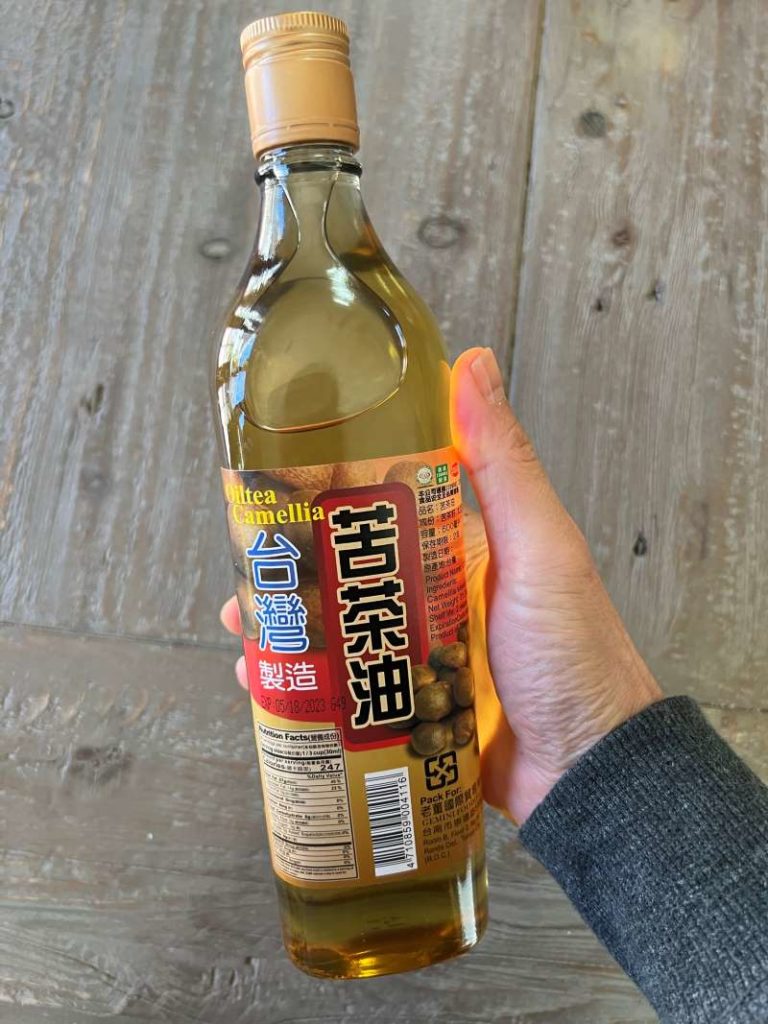
Camellia seed oil has a delicate texture and mild nuttiness. Above is the brand that I purchase in San Jose; it's the only one sold at Lion Foods. It contains camellia seed oil plus soybean oil. I'm unclear how much soybean oil is in the mix but when used for cooking, the oil lends a subtle nutty lushness. It's not life changing but makes nice tasting food that doesn't taste greasy. This bottle was about $10 so it is not outrageous priced for a specialty product. Try it in salad dressings too. If you'd like 100% organic camellia seed oil, consider this one available from vendors like Amazon. Camellia seed oil is sometimes called bitter tea oil but I taste no bitterness in the bottle.
What is camellia seed oil? The oil is produced from the Camellia oleifera tree, a relative of Camellia sinensis, the tea plant from which tea leaves are plucked. It is not the same as the tea tree oil used topically for skin treatment. Japanese tsubaki camellia oil is made from Camellia Japonica. Tsubaki oil is used for skin and hair, and to prevent carbon steel knives from rusting! I noticed that the organic camellia seed oil I pointed to earlier says it may be used for skin and hair so you give it multipurpose try!
Sesame and Coconut Oil Plus Duck Fat
Sometimes you want to pump up the flavor in a stir-fry. Sesame oil is great for finishing, though you may add a whisper at the front end along with another oil that's higher in smoke point to lay a foundation for sesame's nutty goodness. When it comes to buying sesame oil, I favor Japanese ones which tend to have bold, clean flavor. There are many options at Korean and Chinese markets too, so look around.
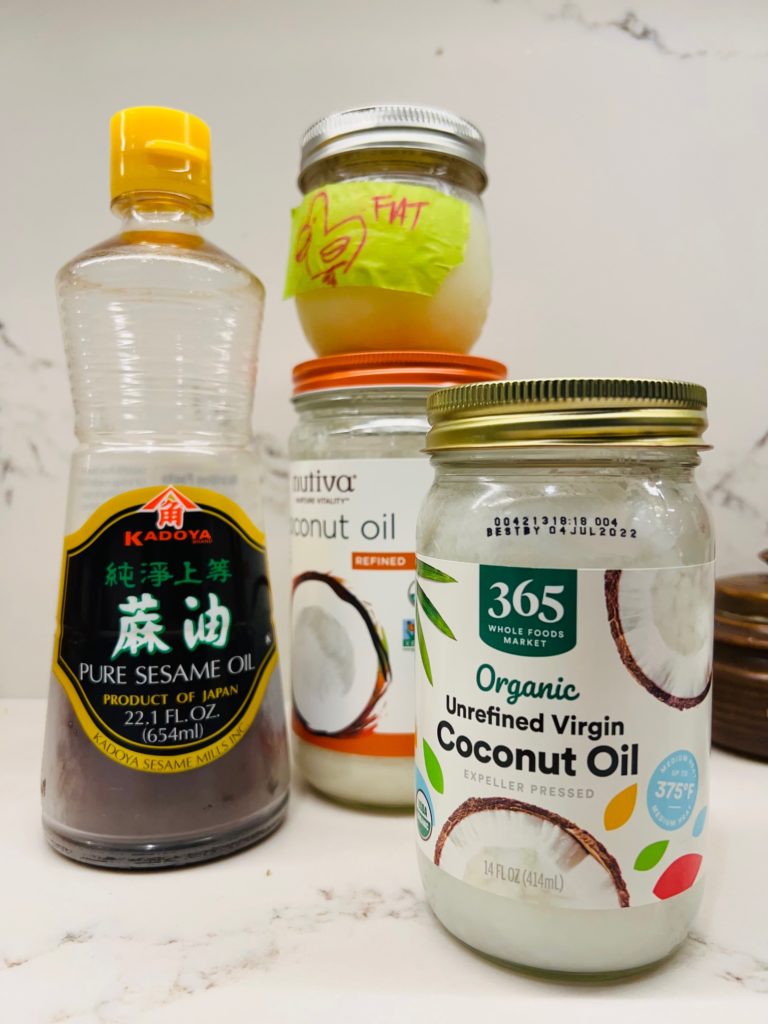
Refined coconut oil will take the heat much better than unrefined (virgin) coconut oil. But if you want a tropical hit -- blend the two. Or, just add some virgin coconut oil to a refined oil of your choice.
How to store unrefined oils? I keep them chilled, and they'll last beyond their expiration date.
Finally, stir-fry with tasty animal fat. I save the fat leftover from roasting my Peking Duck in a jar in the fridge! Just a little is needed for an incomparable richness.
This is not an exhaustive list of all your options. But you can stir-fry with easy-to-find supermarket oils, or special ones from an Asian market. You may also blend and experiment!

















Gail says
I'd like to add a plug for rice bran oil. I dislike canola oil because I think it has an unpleasant fishy odor when heated. I used peanut oil for many many years and was happy with it, but discovered rice bran oil a few years ago, and it is now what I use virtually every day. It has a pleasant aroma of fragrant rice. It is from Thailand, available in a large jug, and I buy it a Vietnamese supermarket.
Andrea Nguyen says
Thanks, Gail. Rice bran is mentioned above. I love its lightness. You are very lucky to have access to rice bran oil at your Viet market! In the Bay Area, I've seen it at H-Mart.
The expeller press canola that I use does not have that smell you mention. I do know what you mean by that aroma.
muerps says
Refined coconut oil is also a good fat for deep frying because - in temperate climates - you can easily dispose of the solidified fat via the household waste. On the other hand, leftover deep frying oil poured down the sink may contribute to the formation of fatbergs.
It's also interesting how even similar countries can have quite different availabilities of cooking oil. In Germany, rapeseed/canola oil is ubiquitous, while your average supermarket will only sell groundnut/peanut oil in teeny tiny bottles (at much higher prices than rapeseed). In the UK, groundnut oil is cheap, while there aren't many brands of rapeseed oil available - although interestingly, bottles labelled simply as vegetable oil often contain 100% refined rapeseed oil if you look at the small print on the back of the bottle. A wok oil I found in a UK supermarket was mostly sunflower oil. Sunflower oil is popular in both countries, while I have never seen cottonseed oil anywhere in either country.
Andrea Nguyen says
That's a great point about refined coconut oil! Oh my, the drain is not where leftover deep-frying oil goes. Yikes. Depending on what you fry, you can filter and reuse the oil.
Fascinating. Roughly 85% of the time, "vegetable oil" in the U.S. is soybean oil.
There's a difference between rapeseed and canola (the former is the mother and the latter is the child). I wonder if rapeseed in the UK is rapeseed and not canola?
The cottonseed oil in that bottle I mentioned at the top of the article is definitely an anomaly. Thank you for contributing your experiences to enrich our discussion here. This makes me very happy.